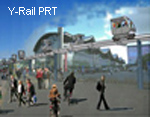Describing and Illustrating the Extended Transit-Oriented Development (E-TOD) Concept
by
Transit-oriented development (TOD) is a concept that is currently very popular in many U.S. cities. (See Robert Cervero's book entitled Transit Villages at amazon.com for details). The idea is to stimulate mixed-use, higher density development to occur within walking distance of a rail transit station. Expected benefits include more ridership on the rail lines, less ownership and use of the auto (hence less congestion), more walking and local shopping, a better "community" feeling and more compact cities (hence less urban sprawl). Critics have pointed out that developers would have to build a very large number of these TODs in order to get a large enough number of people living in them to achieve these benefits on a scale significant enough to be noticed. This criticism is certainly valid but it can be overcome by using the Extended TOD or E-TOD concept.
The E-TOD would utilize one or more intermediate capacity mobility systems to provide access between the rail station and locations more distant that 1/4 mile (walking distance) from the rail station. In addition to providing feeder/distributor service to the rail station, they would also provide local circulator service within the area surrounding the rail station. Such systems would encourage the development of vacant or underused land and allow conversion of land now used for parking for other non-auto purposes. Overall, the objective of creating a more compact but still very livable urban neighborhood could be achieved rather easily.
This network will be referred to as a Feeder-Distributor-Circulator (F-D-C) network. It would enhance the ridership on the high capacity rail transit line by making the rail station easy to get to and from quickly without the use of an auto. It would also make it possible for people living in the area to reach a variety of local retail and office destinations without using an auto. On a larger scale, several of these F-D-C networks would provide people with access, via transit, to thousands of destinations in the region without requiring the use of an auto. By expanding an existing, downtown-oriented rail system in this way, significant numbers of people could be expected to use transit for trips now made by auto and compact urban, mixed-use development, could be encouraged that would contribute to a reduction in urban sprawl.
The E-TOD would also make use of the Urban Oasis concept, put forth by Architect Roxanne Warren in her book on this topic. The Urban Oasis is a pedestrian-oriented, high density, walkable development that is like a TOD except that it does not have a high capacity rail station in its midst. Instead, is is offset at some distance from a rail station and is connected to it with an automated peoplemover system to provide fast, easy and direct access to/from a nearby rail station.
The E-TOD approach seeks to combine the TOD and Urban Oasis concepts by adding a connective F-D-C network, using one or more of several transportation modes that are now or soon will be available. These could range from special bike paths to the more sophisticated automated peoplemover systems like Personal Rapid Transit (PRT). Some examples are shown below. Click on them for more details.
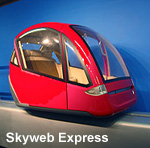 |
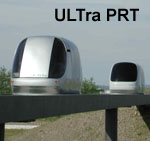 |
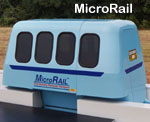 |
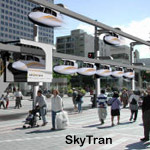 |
 |
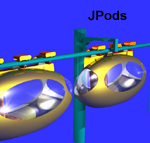 |
|
Vectus PRT |
 |
 |
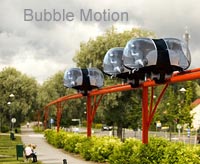 |
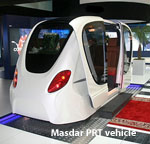 |
Other examples of intermediate capacity possibilities include electric scooters, Dial-a-Ride paratransit vehicles, small monorails , small shuttle buses and station cars (also see the National Station Car Association website ).
Several other possible urban mobility systems are described at the Innovative Transportation Technologies website.
There are several extended TODs at master-planned, predominantly residential new towns, in Singapore. The long-range (Year "X") plan envisages a spider web -- a 3-tier hierarchy of radial heavy rail, orbital (mainly light rail), and tertiary AGT/people mover circulators.
At two new towns -- Bukit Panhang and Sengkang -- the AGT circulators exist. The elevated AGT circulators run as figure-8 loops, tying into the metro rail and effectively extend the reach of TOD many orders of magnitude.
Maps and other illustrations are available at: http://www.cities21.org/extendedTOD.htmHere is a recent YouTube video that describes how ULTra PRT could be used to enhance high capacity mass transit systems
F-D-C means Feeder-Distributor-Circulator
Two illustrations of the E-TOD concept are shown here. The first one is intended to describe how developments in three successive phases around two adjacent high capacity rail stations might occur. They include several Urban Oases as well as pedestrian-oriented TODs adjacent to the rail stations. Only a few of the many other major destinations that could be served by the F-D-C network are shown but access to them would be available from the stations shown on these networks.
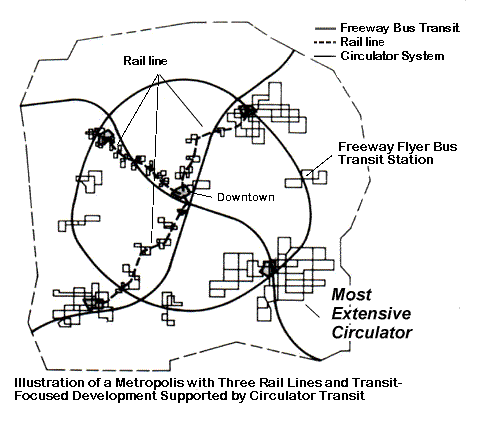 The second illustration is metropolitan in scale and
shows what the major transportation network might look like after several years of
emphasis on transit-focused development and construction of circulator systems to provide
F-D-C services in local areas. Three rail lines are shown as are many circulator systems,
most connected to rail stations, others service express bus service on the circumferential
freeway (i.e. Freeway Flyers).
The second illustration is metropolitan in scale and
shows what the major transportation network might look like after several years of
emphasis on transit-focused development and construction of circulator systems to provide
F-D-C services in local areas. Three rail lines are shown as are many circulator systems,
most connected to rail stations, others service express bus service on the circumferential
freeway (i.e. Freeway Flyers).
It is assumed to be likely that the networks would be expanded over time rather than
being built all at once (e.g. Phases I, II and III). The ride times on this network would
be in the 3-10 minute range and the transfers required at the rail station would be
seamless and very easy. Some walking would be required in many cases to/from all F-D-C
stations. Auto parking areas at the rail station would be small, but other parking areas
that provide easy access to the F-D-C network stations would provide quick and direct
access to the transit system in a park/ride mode.
More details on this
concept are provided in an article that is available on-line.
Comments and criticisms are welcome and should be addressed to: Jerry Schneider
Last modified: February 21, 2012

